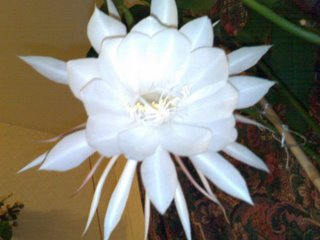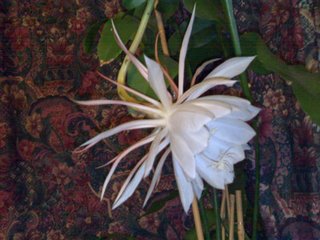My aunt's got this plant. It was quite unimpressive. Just looked like any other big green houseplant. Little did I know what it truly was.
It was about 20 minutes ago that she knocked on my door. "Do you want to come see the flower?" she'd asked. Needless to say, it was an unusual question. So up I got out of bed, leaving behind Trudi Canavan's Last of the Wilds, wondering just what was so special about a flower.
Imagine my surprise when she showed it to me. The mediocre little houseplant had sprouted a rather fetching accessory.

Despite being slightly scary in its size and unsettlingly arachnoid shape, it is a sight to behold, non? Apparently it blooms but once a year at night, and lasts only a few hours. Intrigued, I endeavoured to find out what this pungently sweet bloom is called, and after about 10 minutes of research, I found it. Ladies and gentleman, I give you...
The Queen of the Night. I prefer its scientific moniker though-- Epiphyllum Oxypetalum. Or you could always go with the Malay name, Bunga Bakawali.
This is my first encounter with the flower; others have been more fortunate.
Monday, October 30, 2006
Thar she blooms!
Added Jan 6, 2010, Under: wicked

































4 comments:
Bro, is it something like the one they showed on Dennis the Menace? Hahaha...the flower where it only like 'open' at a certain time... :P
Trying to find something appropriate to comment i guess..hahaha
I think it is haha.
Wow, what a coincidence you bumped ito me blog! :D Yea, but you're so lucky your pictures lawa. Mine so crappy :(
But yea. It is also called the "Midnight Blooming Syrus". :)
I assume Syrus is a simple mispronunciation. It's actually Cereus. Pronounced KER-EE-US. It's an abbreviation of the scientific name of the genuine Queen of the Night (Selenicereus Grandiflorus), which is a variety of cactus.
Though technically, this houseplant variety is not a true Selenicereus, because they've been cross-bred with species from the Epiphyllum genus to make them more durable, thus the new scientific name. So I think the name Cereus might not really apply here since this is an Epiphyllum breed.
Post a Comment